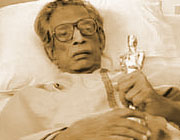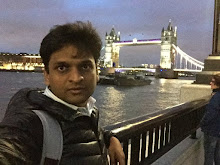
Immediately after watching Pather Panchali, I went to a bookstore and bought Speaking of Films written by Satyajit Ray. It is a collection of essays and articles on various aspects of movies and moviemaking written by Satyajit Ray. This book is published marking the 50th anniversary of release of the classic “Pather Panchali”. Film buffs and aspiring moviemakers may consider this book as a treasure. I haven’t read many books on moviemaking except for “Thiraikathai Yezhuduvadhu Yeppadi (How to Write Screenplay)” by Sujatha.
But reading this book is a totally new experience. It is almost like a textbook on filmmaking. The depth of details that Ray describes about movie making is stunning, revealing and interesting. Ray has great knowledge about world cinema. While reading his comments on Indian cinema and other world cinema, I felt Ray is not just a great filmmaker but also a great (harsh) critic. The extent to which he analyses each and every scene in the movie is a lesson to the professional film critics know, who does nothing except for filling half of the page with the story of the movie and rest to write one line about other very well known aspects of the movie which even a commoner will be able to say. The one basic principle of movie making that Ray keeps repeating on the book is “A Cinema should speak and communicate through visual images and sounds and not through dialogues”. I was really surprised to know how obsessed with western classical music (as I too am) Ray was. At many places, while explaining on movie making techniques he uses western classical music for the analogy and now I know how he himself turned as a composer (and won national award for best music) for his films.
In “My life, My Work”, he talks a lot about how and why he became a movie maker and why “Pather Panchali” is the way it is. He says that he wanted to break all conventions in Bengali cinema. The explanation of first 7 minutes of the movie “Charulatha” is another great part of this article. He explains how those 7 minutes of silent happenings communicates content of so many pages of a novel without even a single conversation or any director’s voice over behind to read about the characters and what they are doing. The interesting part of the next article, “making of a film” comes when he describes the screenplay and various technical aspects of last 5 minutes of “Pather Panchali” in detail.
Language of Cinema: Then and Now (1969) has lot of insight details about language used by various great movie makers and the evolution of new techniques of film making in all parts of the world. The major emphasis here is on the slapstick comedy. And so he talks more about Chaplin and Buster Keaton who were considered the fathers of Slapstick comedy and the techniques they used to make their comedy appealing on screen. “Soviet Cinema” tells about the evolution of cinema in Russia and some of the great works in Russian cinema. I should say this is the article I liked the least because it is just a history of Russian cinema and touches a very little upon the movie making techniques.
The subsequent articles focus largely on Bengali cinema. It is very evident how much Ray hated the theatrical approach in every aspect of movie making followed by Bengali filmmakers. He also tries to strike a balance saying that the pressure of making the movie commercially successful was responsible for less aesthetic movies in Bengali and also adds that with very little exposure about the techniques in movie making, the level of technical expertise that Bengali makers have shown cannot be seen if it were the same condition in any other part of the world. He also gives a rather surprising practical reason for Ray’s reluctance towards making films dealing with urban issue.
The article Background Score in films is an eye-opener. I suggest all the composers must read this article. I thought he would speak more about the symphonic background scores used in Hollywood films but he restricted his article to just about that in Bengali films. I would say this article is the most interesting one (to me) in the book. He talks in length about the evolution of background score in films, when and why it is necessary for a film and how he used it in his own films. He also explains certain norms and principles by which a score has to be written for a film.
Dialogues in films has nothing new to say. He again emphasize on his basic principle that only images should speak in a film and the dialogues should be treated as an alternative for communication. And if it were used, it should be as real as possible.
Colors in films is another interesting article about filmmakers reluctance in using color for serious films those days. He clearly puts forward that such a notion is absolutely wrong. Color is just another visual technique that takes a film close to the reality and it can be used for movies based on serious issues also. He also adds many examples to prove how colors make the job of a filmmaker easier by providing various ways to convey a lot through images. He also criticizes the way the colors were used just for glamour in Hindi films.
All those so-called professional film critics have a great lesson in the article Critics in the eyes of a director. And the next two articles are Ray’s angry take on worst criticisms on his films “Apur Sansar” and “Charulatha” that got published in magazines. Both the reviews had comparisons of the movie with the actual novel from which the screenplay is adapted. He quotes each and every line of those reviews and explains how invalid they were by illustrating it with all necessary details from the novel and the scenes in the movie. Ray has trashed those critics extremely to an extent they might have left the job and ran away out of shame.
Indir Thakran is an article about how much Ray admired the professionalism of this 70 year old actress Chunibala devi who enacted the role of Indir in Pather Panchali. It was indeed great to know about one who gave one of the most realistic performances on Indian screen ever. In “A Quarter of a century” he writes about how much he has evolved as a filmmaker in last twenty-five years and talks about his own favorites scenes from movies of his own. Other articles are nothing to do with cinema. They are about Ray’s unforgettable personal friends.
Now after reading this book, I am on my way to buy “Our Films, Their films”.
12.19.2005
Speaking of Films - Satyajit Ray
Posted by P.S. Suresh Kumar at 1:44 PM
Subscribe to:
Post Comments (Atom)



6 comments:
First, my special thanks for writing such a detailed review on the book.
I was completely hooked to Satyajit Ray's movies after watching them a couple of months back. I've written more on that in my blog as it runs little longer.
hi,
thanx for visiting my blog and pouring your thoughts here. I checked your blog. it is cool and i have blogrolled you. I have seen only "Pather Panchali" and i am yet to see his other master works.
Aparajito was the best among the two I saw. I still can't get some characters out of my mind (especially the grand mother character). Watch it.
Satyajit Ray is good. One of a kind. This new book is not available @ amazon.com. I saw some striking similarity of Ray in Krzysztof Kieslowski [Blue, White, Red].
ramesh: i bought the book from Landmark in chennai, india.
Speaking of Films by Satyajit Ray PDF
Post a Comment